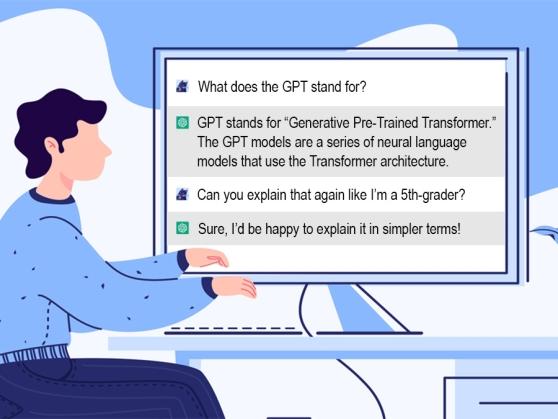
ChatGPT’s ability to generate content tailored to a student’s language level is one of the many ways it can be helpful for educators.
ChatGPT, a new artificial intelligence tool launched in November 2022, has the potential to be a game-changer for both students and teachers.
Soon after its release, both New York City and Los Angeles school districts banned access to it on their networks and devices out of concern that students would use it to cheat.
Yes, the possibility that students will use it to write essays and research papers is a valid concern. But given that artificial intelligence is developing at breakneck speed, the more pressing question for educators is: How can we use it to our advantage?
Freely accessible to all at chat.openai.com, ChatGPT, which was developed by Open AI, can instantly produce everything from a traditional five-paragraph essay on the factors that led to the Spanish-American War to an original poem about alpacas written in iambic pentameter. (I gave ChatGPT both these assignments. The essay was fine, but its alpaca verses were a delight.)
What truly distinguishes ChatGPT from other, more rudimentary, chatbots is its ability to draw from and refine previous interactions and to emulate natural human language while doing so. After I asked ChatGPT to tell me what the GPT in its name stands for (“Generative Pretrained Transformer”) and what it means (“a type of neural network architecture developed by OpenAI for natural language processing tasks”), I asked if it could explain it to me again like I was a 5th-grader.
“Sure, I’d be happy to explain it in simpler terms!” ChatGPT responded and proceeded to do so.
Jeffrey Ellis-Lee, an Advanced Placement (AP) government teacher at the Maxine Greene HS for Imaginative Inquiry in Manhattan, initially approached ChatGPT with a sense of impending doom.
“I asked it to answer various essay questions from past AP exams, and it was amazing — the answer was perfect,” he said. “I thought, ‘What am I going to do?’ I give a lot of writing assignments in my class and I use those writing assignments to tell me what I need to teach next. If my students use ChatGPT, everything they turn in is useless.”
But simply forbidding the tool felt like a losing strategy. “Even if the school blocks it, students are going to use it. It’s a reality we’re all going to face,” he said.
So Ellis-Lee set out to defeat ChatGPT — and any potential attempts to use it to cheat — at its own game. He asked his 12th-graders to evaluate ChatGPT’s responses to essay questions using the seven-point AP rubric. Then he distributed a revised rubric with an extra criterion: sophisticated language.
“The AP rubric is looking for very specific terms about government, and I imagine ChatGPT has internalized that rubric,” he said. “But I know teenagers love challenges, so we had a competition: Who can write it better than the computer? It was exciting, and it went great.”
He did a similar activity in his finance course, asking students to use skills he had taught to help them evaluate ChatGPT’s advice about buying stocks.
A March 2023 study showed that teachers actually report using ChatGPT more than students. Their observations indicate they won’t be handing over their teaching licenses to ChatGPT just yet.
“I asked ChatGPT to write a lesson plan on the topic of centripetal force. The plan was pretty bad,” said Julia Hall, a physics teacher at Medgar Evers College Preparatory School in Crown Heights, Brooklyn. “It wrote a fairly boring lecture that read like an encyclopedia entry.”
But the tool can be a time saver for educators, giving them the opportunity to focus on more creative and challenging tasks.
Hall used ChatGPT to generate a letter to alert parents if their child is in danger of failing physics. “From a fairly basic prompt, it generated a lovely multi-paragraph message that got the central point across but also gave some good tips to parents in terms of helping their child in the class,” she said. “It probably saved me a good hour of work.”
Ellis-Lee, too, was less than pleased with his attempt to generate a PowerPoint presentation for class using the tool. On the other hand, ChatGPT “was great at being a research assistant,” he said. “If there were issues you wanted to present two to three perspectives on, it would help you gather information.”
After spending time evaluating ChatGPT’s strengths and drawbacks, Ellis-Lee concluded his initial fears about the chatbot were put to rest.
He believes students would not be able to easily get away with using it to cheat. “I’d like to say most teachers know their students and know what they’re capable of,” he said.
In the end, he said, ChatGPT is simply another implement in educators’ expanding toolkit.
“We just have to learn how to incorporate it into our teaching,” he said